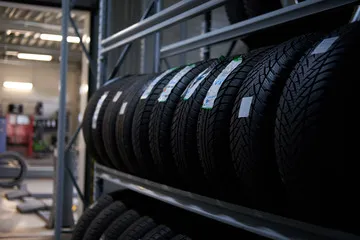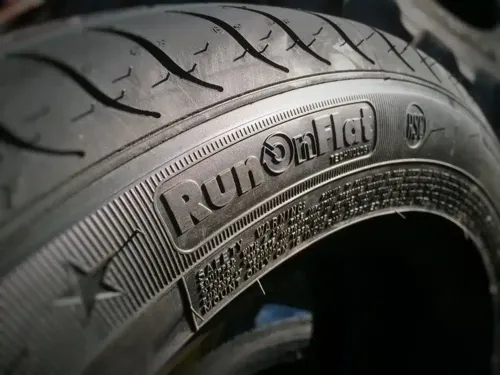Speed Rating on Tyres Explained
Understand tyre speed ratings and how they affect your vehicle's performance and safety.
Posted on

When it comes to choosing the right tyres for your vehicle, one important factor to consider is the speed rating. The speed rating is an often-overlooked tyre specification that directly impacts your vehicle’s performance and safety. But what exactly does it mean, and how does it affect your driving?
In this guide, we’ll explain everything you need to know about tyre speed ratings, how they’re determined, and why they matter for your vehicle.
What is a Tyre Speed Rating?
A tyre speed rating indicates the maximum speed a tyre can safely maintain over time under optimal conditions. This rating is represented by a letter found on the tyre’s sidewall, typically following the tyre size information. For example, you might see something like 225/45R17 94V. In this case, the letter “V” is the tyre’s speed rating.
Speed ratings are determined through rigorous testing, where the tyre is run at increasingly higher speeds until it reaches its limit. The rating helps ensure that the tyre will perform safely at the speeds for which it is designed.
How to Read Tyre Speed Ratings
Tyre speed ratings are represented by letters, and each letter corresponds to a specific maximum speed. Here’s a table of common speed ratings and their associated maximum speeds:
| Speed Rating | Maximum Speed (mph) | Maximum Speed (km/h) |
|---|---|---|
| Q | 99 mph | 160 km/h |
| S | 112 mph | 180 km/h |
| T | 118 mph | 190 km/h |
| H | 130 mph | 210 km/h |
| V | 149 mph | 240 km/h |
| W | 168 mph | 270 km/h |
| Y | 186 mph | 300 km/h |
| ZR | Over 149 mph | Over 240 km/h |
It’s important to note that the speed rating is based on sustained speeds, not short bursts. In other words, the rating indicates the highest speed the tyre can handle consistently without risk of failure.
Why Speed Ratings Matter

- Safety: The primary reason to pay attention to tyre speed ratings is safety. If you frequently drive at high speeds, especially on motorways, using tyres with a lower speed rating can increase the risk of tyre failure, including blowouts.
- Performance: Higher-rated tyres are designed to offer better handling, cornering, and overall stability at higher speeds. If you have a performance vehicle or enjoy spirited driving, choosing tyres with a suitable speed rating can enhance your driving experience.
- Legal Requirements: In some regions, fitting tyres with a speed rating lower than the vehicle’s capabilities can result in a failed MOT (Ministry of Transport) test or legal penalties. Always ensure your tyres meet the manufacturer’s recommendations for speed rating.
How to Choose the Right Speed Rating
When selecting tyres for your vehicle, it’s essential to choose a speed rating that matches or exceeds the recommendation from the vehicle’s manufacturer. Here’s how to ensure you’re making the right choice:
1. Check the Manufacturer’s Recommendation
Your vehicle’s manual or the tyre placard inside the driver’s side door frame will indicate the recommended tyre specifications, including the speed rating. Always match or exceed this rating when purchasing new tyres.
2. Consider Your Driving Habits
- Daily Commuters: If you mainly drive in urban areas or on lower-speed roads, a tyre with a moderate speed rating (S, T, or H) will be suitable.
- Motorway Drivers: For those who frequently drive at high speeds on motorways, tyres with higher speed ratings (H, V, or W) are recommended.
- Performance Vehicles: If you drive a high-performance vehicle, you’ll likely need tyres with higher speed ratings like V, W, or Y to handle the increased speeds safely.
3. Factor in Weather Conditions
Speed ratings are based on optimal conditions. However, driving in adverse weather (rain, snow, ice) or on poor road surfaces can affect tyre performance. Always consider the typical weather conditions where you drive most often.
Can You Use a Tyre with a Lower Speed Rating?
Technically, you can use tyres with a lower speed rating, but this is not recommended for several reasons:
- Safety Risks: Driving at speeds above the tyre’s rating can cause excessive heat, leading to a higher risk of blowouts.
- Reduced Handling: Tyres with lower speed ratings may not provide the same level of handling and stability as higher-rated ones, especially at motorway speeds.
- Legal Issues: In some countries, fitting tyres with a lower speed rating than the manufacturer’s recommendation can be illegal or cause issues during inspections, such as failing an MOT test.
Can You Use a Tyre with a Higher Speed Rating?
Yes, using a tyre with a higher speed rating than recommended is generally acceptable and may even improve your vehicle’s performance at higher speeds. However, higher-rated tyres tend to be more expensive, so unless you regularly drive at high speeds, you may not need to pay the extra cost.
Common Myths About Tyre Speed Ratings
- Myth 1: Higher speed-rated tyres are always better
While higher speed ratings may offer improved performance, they are designed for specific driving conditions. Unless you regularly drive at high speeds, tyres with moderate ratings (S, T, H) may be more than sufficient. - Myth 2: Speed ratings are only for high-performance vehicles
Speed ratings apply to all tyres, not just those on sports cars. Even family cars and SUVs need tyres with the correct speed rating to perform safely. - Myth 3: Tyre speed ratings affect fuel efficiency
The speed rating itself does not directly impact fuel efficiency. However, tyres designed for higher speeds often use softer compounds, which can slightly reduce fuel economy compared to harder compounds used in tyres with lower speed ratings.
Conclusion: Speed Ratings Keep You Safe
The speed rating on your tyres is more than just a number—it plays a vital role in your vehicle’s safety and performance. Ensuring that your tyres match or exceed the manufacturer’s recommended speed rating will help you avoid unnecessary risks on the road. Whether you’re driving in the city or cruising on the motorway, maintaining the proper tyre speed rating is essential for optimal vehicle performance and safety.










